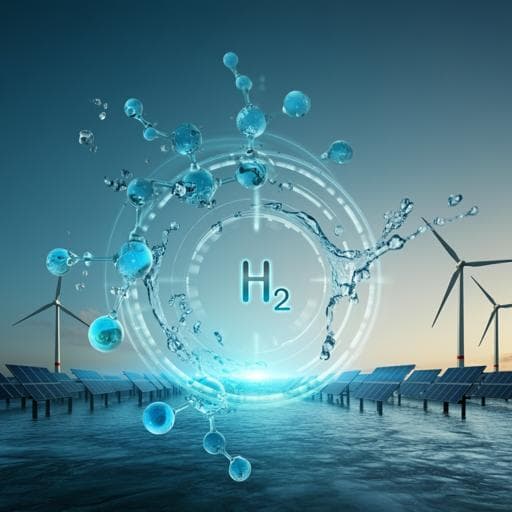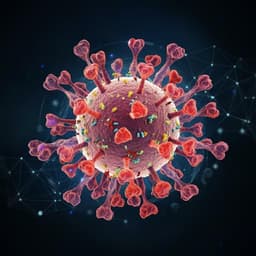
Engineering and Technology
Hydrogen production from the air
J. Guo, Y. Zhang, et al.
This groundbreaking research by Jining Guo, Yuecheng Zhang, Ali Zavabeti, Kaifei Chen, Yalu Guo, Guoping Hu, Xiaolei Fan, and Gang Kevin Li unveils a revolutionary method for directly producing hydrogen from ambient air. Using direct air electrolysis, powered by renewable energy, this technology offers a sustainable solution to water scarcity in hydrogen production, especially in remote areas.
~3 min • Beginner • English
Introduction
The study addresses the challenge that freshwater scarcity imposes on geographically optimal deployment of renewable-powered water electrolysis. Large arid and semi-arid regions with strong solar and wind resources lack accessible freshwater, and desalination adds cost and complexity. Prior alternatives (direct saline splitting, vapor-fed electrolysis requiring inert carrier gases, photocatalytic splitting with low solar-to-hydrogen efficiency and mixed H2/O2 outputs) have limitations in product purity, efficiency, or practicality. The authors propose harvesting atmospheric moisture in situ using hygroscopic electrolytes within a porous medium, enabling direct air electrolysis (DAE) to produce high-purity hydrogen without liquid water feed, even at very low relative humidity. The purpose is to demonstrate feasibility, characterize performance, stability, and scalability, and to show compatibility with intermittent renewables (solar, wind).
Literature Review
The paper reviews approaches to mitigate water shortages for electrolysis: direct seawater/saline electrolysis faces brine management challenges; anion-exchange membrane electrolyzers using humidified feeds require inert gas purge at the cathode, yielding low H2 purity (<2%); photocatalytic water splitting can use vapor feeds but shows low real-world solar-to-hydrogen efficiency (~1%) and co-evolves H2/O2 requiring separation. Vapor-fed devices have reported modest hydrogen production rates (mostly <65 in comparable units), and some systems operate only at higher humidity or elevated temperatures (>60 °C), limiting use in (semi-)arid environments. The authors compare their DAE with prior solar-driven water/vapor splitting reports, noting substantially higher production rates and long-term stability, and discuss DOE solar-to-hydrogen efficiency targets that prior systems have not exceeded broadly.
Methodology
System design: The DAE module has a sandwich architecture with a central water-harvesting unit (porous medium reservoir soaked with a hygroscopic ionic solution) and electrodes with separated gas collectors on both sides. The porous medium (e.g., melamine sponge or sintered/Si-doped glass foam; quartz wool interlayers to ensure liquid connectivity when using glass foam) absorbs atmospheric moisture via deliquescent electrolytes and transports the resulting aqueous electrolyte to the electrode interfaces for in situ electrolysis. A peripheral reservoir acts as an air barrier and buffer to accommodate electrolyte volume changes with humidity, preventing overflow or dry-out. The foam filled with ionic solution physically isolates hydrogen, oxygen, and ambient air, enabling separate gas collection.
Hygroscopic electrolytes and electrodes: Tested hygroscopic substances include CH3COOK (salt), KOH (base), and H2SO4 (acid). Each absorbs moisture to form an ionic solution capable of supporting electrolysis. Electrodes included Ni foam and Pt mesh; current feeders/distributors used Teflon plates with Pt wires (99.99%). For KOH with Ni electrodes at 60% RH, current densities reached 273 mA cm⁻² at 3.0 V and 574 mA cm⁻² at 4.0 V; at 15% RH, 177 mA cm⁻² at 3.0 V. However, KOH performance degraded over 72–96 h due to carbonation (KOH → K2CO3 → KHCO3) from CO2 exposure. H2SO4 was identified as a superior hygroscopic electrolyte capable of moisture uptake at RH as low as ~5%. Melamine sponge in H2SO4 initially offered lower series resistance and higher current density (up to ~150 mA cm⁻²) than glass foam due to higher pore openness, but the sponge degraded in H2SO4 over about a week, so subsequent tests used H2SO4-soaked glass foams with Pt mesh electrodes. Si-doped glass foams were selected for improved conductivity and reduced resistance.
Device geometry and operating conditions: Sintered glass foams G1–G3 had pore sizes 50–70, 30–50, and 16–30 µm, respectively. Foam thickness affected resistance per Pouillet’s law; thinner foams (1.5 cm versus 2.5 cm) improved current density at a given voltage. A 1.5 cm total thickness (with quartz wool layers) balanced water absorption area and conductivity and was used for detailed studies. Temperature elevation from 25 °C to 45 °C increased current density at 3.0 V due to higher H2SO4 conductivity. The operating equilibrium H2SO4 concentration tracked ambient RH, providing a vapor–liquid driving force for continuous water uptake during electrolysis. The electrolyte freezing points at relevant concentrations were below −30 °C, implying potential operation in cold arid climates.
Performance characterization: J–V curves were measured at 25 °C across RH 20–80% for various foam pore sizes and thicknesses, with extended stability runs up to 288 h. In a climate chamber (DHT-100-4P-SD), DAE modules were powered by DC supplies (DP3031U; PR-SPS05D for foam-free cell). For foam-free benchmarking, a 50 mL electrochemical cell with 1.5 cm electrode spacing and 4 cm² electrode area was tested by stepping voltage (H2O: 1.80–3.00 V; KOH: 1.00–4.00 V; 100 mV per 30 s), recording current after 30 s; each condition repeated three times. For DAE modules, constant current density operation was maintained, with checks every 4 h over 8 h periods; J–V behavior before/after 24–48 h at each RH was recorded. Series resistance Ri was used for iR-compensation: V_comp = V_original − J·Ri.
Gas analysis and Faradaic efficiency: Cathode and anode gases were collected via water displacement in inverted cylinders and analyzed by GC (Agilent 7890B, TCD; HP-INNOWAX, HP-PLOT U, CPMolesive 5 Å columns). Faradaic efficiencies for H2 and O2 were calculated by comparing measured gas evolution rates to ideal rates, using P0=101,325 Pa, T=298.15 K, R=8.3145, F=96,485 C mol⁻¹, and electrode area S (cm²).
Stability testing: A 55.2 wt% H2SO4 electrolyte (prepared from 98% H2SO4 without added water) was operated at 40% RH and 25 °C for 12 consecutive days at constant 15.0 mA cm⁻², monitoring voltage and gas output.
Open-air prototypes: A solar-driven prototype stacked five DAE modules vertically with a commercial silicon solar panel (Voc ≈ 6.0 V; Isc ≈ 400 mA) on top. Outdoor testing recorded time-resolved current and H2 generation; daily H2 volumes were measured by water displacement. A wind-driven prototype coupling a DAE module to a wind turbine was also demonstrated.
Key Findings
- Demonstrated direct air electrolysis (DAE) that harvests atmospheric moisture and electrolyzes it to produce hydrogen without liquid water input, operating at relative humidity as low as 4%.
- Achieved high current densities: with KOH/Ni electrodes, up to 273 mA cm⁻² at 3.0 V and 574 mA cm⁻² at 4.0 V (60% RH); 177 mA cm⁻² at 3.0 V at 15% RH. With H2SO4 electrolyte and optimized porous media, current densities improved with thinner Si-doped glass foams and higher temperature (e.g., at 3.0 V, current density increased from ~37.8 to ~44.8 in stated units when temperature rose from 25 °C to 45 °C).
- Faradaic efficiency around 95% during extended operation; GC analysis indicated ≥99% H2 purity at the cathode and high purity O2 at the anode.
- Stability: A DAE module with 55.2 wt% H2SO4 ran continuously for 12 days at 15.0 mA cm⁻² (40% RH, 25 °C) with stable performance. KOH-based modules showed performance decline after ~72 h due to carbonation (KOH → K2CO3 → KHCO3).
- Outdoor solar prototype (five parallel modules) produced about 1.49 L H2 on day 1 and 1.18 L on day 2 under non-ideal weather; reported average hydrogen generation rate up to ~745 L h⁻¹ m⁻² of electrode area in demonstration. Current output tracked solar intensity, peaking around 400 mA mid-day.
- The DAE approach compares favorably with vapor-fed electrolyzers, showing higher practical hydrogen production rates and operation in (semi-)arid conditions; theoretical solar-to-hydrogen (STH) efficiencies projected up to 24.9% (H2O with best solar panel) and 32% (with KOH hygroscopic electrolyte), surpassing the DOE 20% STH target under optimal coupling assumptions. Wind-driven operation was also validated.
Discussion
The findings demonstrate that in situ atmospheric moisture capture coupled with electrolysis can overcome freshwater supply constraints and enable green hydrogen production in locations with ample renewable energy but limited water. By isolating electrodes from ambient air within a hygroscopic, porous reservoir, the DAE maintains high product purity and Faradaic efficiency while operating at very low RH (down to 4%). Materials engineering (electrolyte choice, porous-medium conductivity, thickness) directly influences resistance, mass transfer, and performance, allowing optimization for energy efficiency and scalability. The validated 12-day stability in H2SO4 electrolyte, along with solar and wind-powered demonstrations, underscores practical feasibility in real-world, intermittently powered contexts. The technology provides a path to deploy hydrogen generation in remote and arid regions without the environmental and economic costs of liquid water sourcing and desalination, while being modular and stackable to minimize land footprint.
Conclusion
This work introduces and validates a direct air electrolysis (DAE) system that harvests atmospheric moisture to produce high-purity hydrogen without liquid water input, functioning at RH as low as 4%. The module achieves high current densities, robust Faradaic efficiency (~95%), and demonstrated stability over 12 days with H2SO4 electrolyte. Prototypes powered by solar and wind confirm real-world applicability, with competitive hydrogen production rates and projected STH efficiencies exceeding DOE targets with optimal solar coupling. Future research should focus on: improving long-term durability of porous supports in acidic media; mitigating CO2 carbonation for alkaline systems (e.g., via CO2 barriers or alternative electrolytes); optimizing porous media (conductivity, thickness, pore architecture) for lower resistance and higher mass transfer; scaling module arrays and integrating with variable renewable power; and validating extended outdoor operation across climates, including cold arid environments suggested by the low freezing points of H2SO4 solutions.
Limitations
- Electrolyte/material stability: Melamine sponge degrades in H2SO4 after about one week; more durable porous media are needed. KOH-based systems suffer from carbonation (KOH to K2CO3/KHCO3) under air, increasing voltage and degrading performance after ~72–96 h unless CO2 is excluded.
- Reliance on precious metal electrodes (Pt mesh) in some configurations may impact cost and scalability.
- Reported long-term stability in controlled conditions spans 12 days; broader, longer outdoor validation is needed. Open-air demonstrations produced modest absolute H2 volumes, indicating further scaling and optimization are required.
- Performance depends on ambient RH and temperature; while operation at low RH is possible, water uptake equilibria impose constraints on throughput without increasing absorber area or improving hygroscopic capacity and transport.
- Trade-offs between absorber thickness (surface area for water uptake) and ionic resistance must be optimized for each deployment scenario.
Related Publications
Explore these studies to deepen your understanding of the subject.







